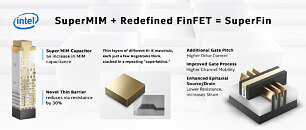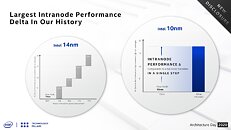Thursday, August 13th 2020

Intel 10nm SuperFin Process Goes up Against TSMC 7nm
Intel on Thursday made several technological disclosures about its latest silicon fabrication process, the 10 nm SuperFin. With this, the company is changing the nomenclature of its node refinements, away from the ## nm++ naming scheme (with each "+" denoting a refinement, or internode), to a more descriptive naming scheme. The new 10 nm SuperFin node is the first refinement of the company's 10 nm node that debuted with the company's 10th Gen Core "Ice Lake" processors last year, and promises energy efficiency in the ballpark of 7 nm-class nodes by competitors TSMC and Samsung. While past generations of internodes (refinements) delivered energy efficiency improvements of around 3-5%, 10 nm SuperFin offers the kind of improvements expected from a brand new node, according to Intel.
The 10 nm SuperFin node is composed of two key innovations, the SuperMIM capacitor and a redesigned FinFET transistor. The new SuperMIM (metal insulator metal) capacitor offers a 5x increase in capacitance compared to devices in this class. The redesigned FinFET introduces a new barrier that reduces via resistance by 30%. Combined, the 10 nm SuperFin node affords chips a V/F curve comparable to a die-shrink to a whole new silicon fabrication node, without any change in transistor density. The first product built on 10 nm SuperFin is the upcoming Core "Tiger Lake" processor addressing the client-segment. The company is already working on enhancements of this node relevant for data-center processors.
The 10 nm SuperFin node is composed of two key innovations, the SuperMIM capacitor and a redesigned FinFET transistor. The new SuperMIM (metal insulator metal) capacitor offers a 5x increase in capacitance compared to devices in this class. The redesigned FinFET introduces a new barrier that reduces via resistance by 30%. Combined, the 10 nm SuperFin node affords chips a V/F curve comparable to a die-shrink to a whole new silicon fabrication node, without any change in transistor density. The first product built on 10 nm SuperFin is the upcoming Core "Tiger Lake" processor addressing the client-segment. The company is already working on enhancements of this node relevant for data-center processors.



20 Comments on Intel 10nm SuperFin Process Goes up Against TSMC 7nm
Nothing like a bizzare voltage/frequency chart with no voltage points in a presentation talking about supposedly "the largest internode performance delta ever".
At what voltage does it hit 4.5 ?
Intel : Yes.
Intel: super super super super super super super super super super super super super super super super super super super super super super super super super super super super super super super super super super super super super super super super super super super super super super super super super super super super super super super super super super super super super super super super super super super super super super super super super super super super super super super super super super super super super super super super super super super super super super super super super super super super super super super super super super super super super super super super super super super super super super super super super super super super super super super super super super super super super super super super super super super super super super super super...
Looking forward to see the actual product in action rather than all this marketing slides. The more I see these sorts of fancy numbers and naming conventions, the more I feel the product is not as great as it sounds.
Intel: shut that "Intel Product Assurance and Security group" down before it taints the company image any further.
They have literally taken up the marketing which the products should do in the marketplace for themselves.
If this goes for long, Intel will literally take up AMD Bulldozer image. This is dangerous guys, you shouldn't underdeliver in any briefing - let alone image yourself after your long time underdog.